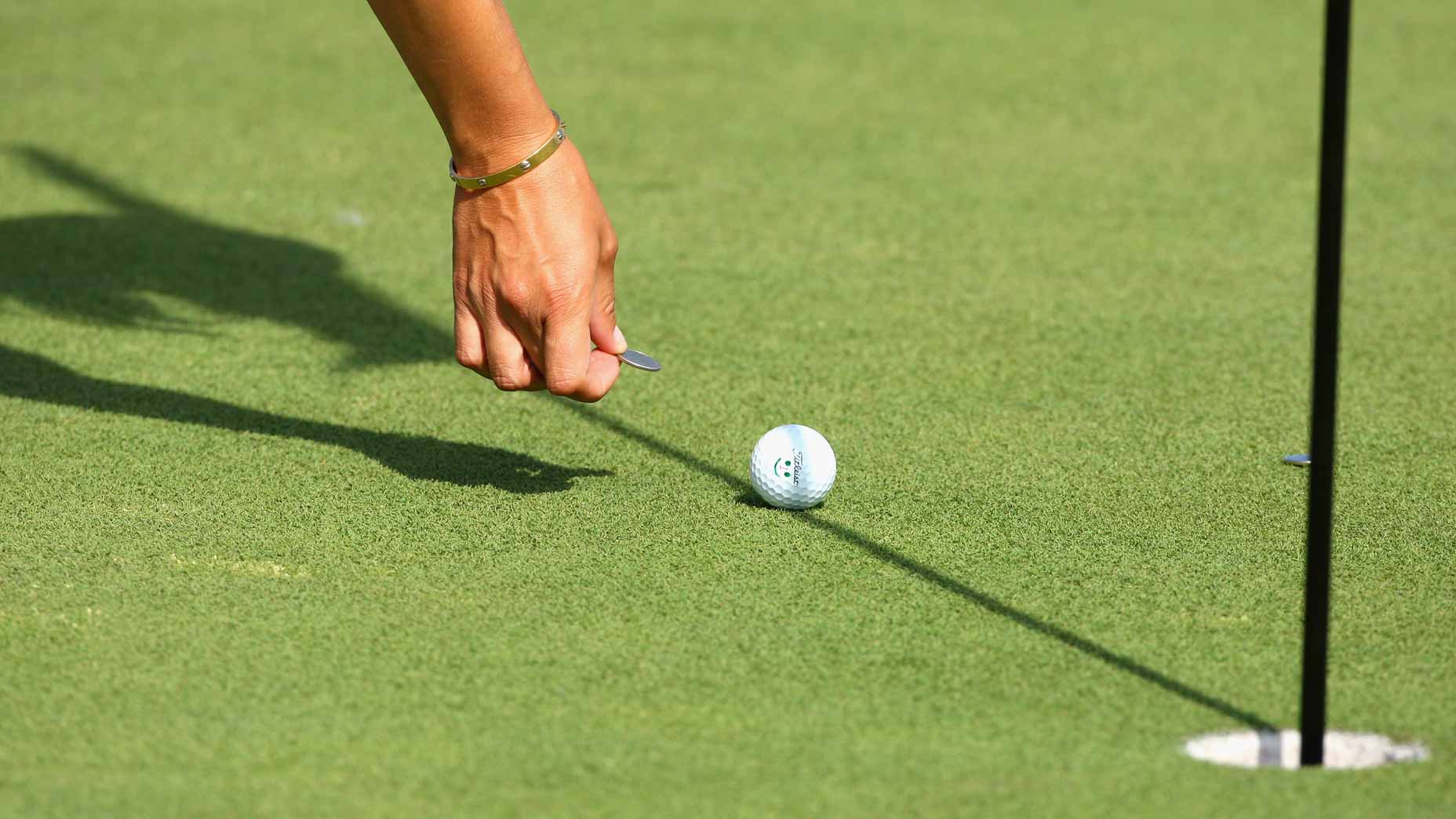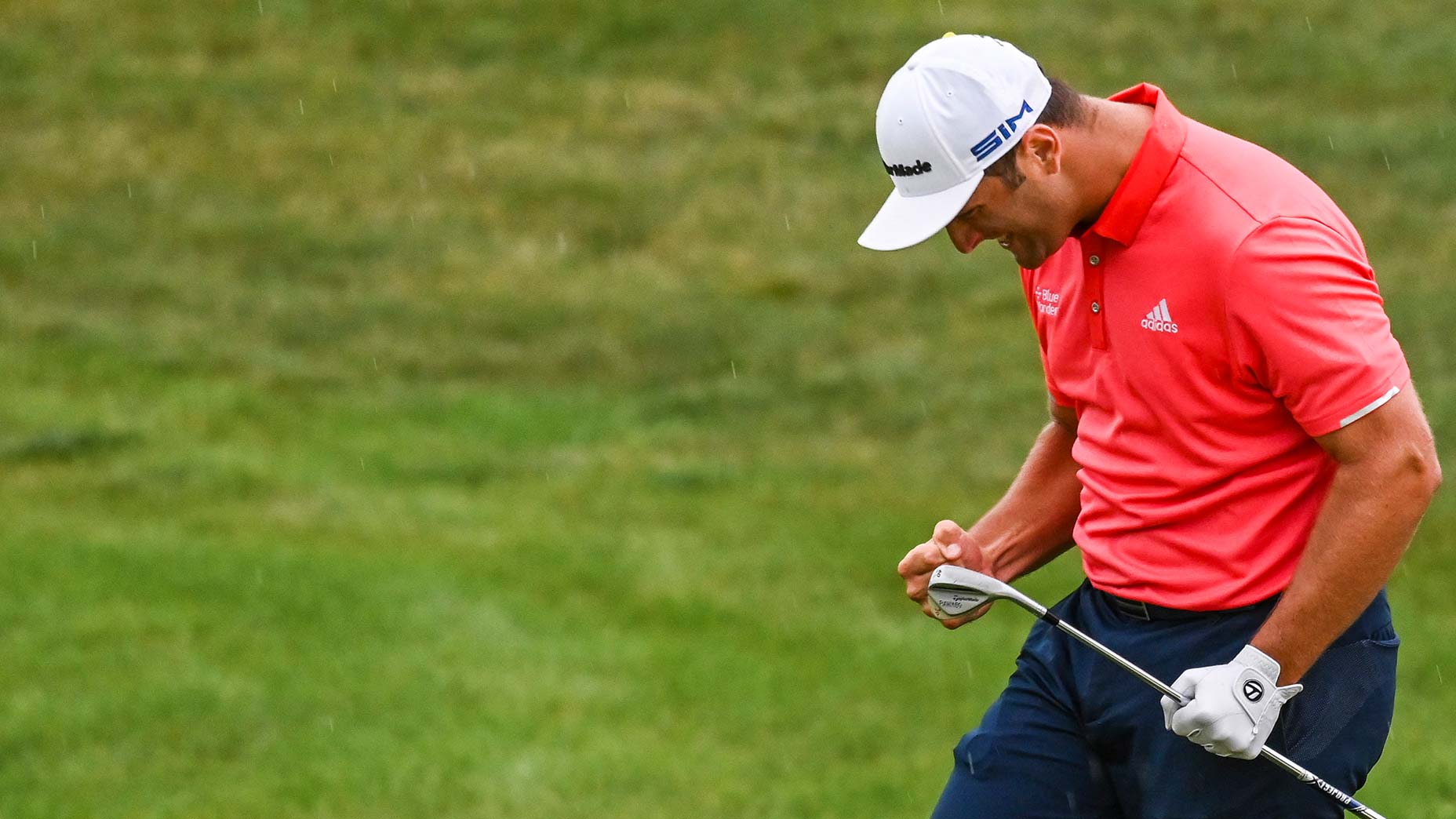
Do alignment lines violate the spirit of golf's original set of rules?
Getty Images
In 1744, The Honourable Company of Edinburgh Golfers drafted the first Articles and Laws in Playing at Golf. It’s a fun and colorful read rich with talk of horses, adversaries and misfortune. A different time, no doubt. The Honourable Company gave us only 13 rules, but their document serves as a Magna Carta of sorts for how we play today. The general ethos: play the ball as it lies, play the course as you find it. That was then.
The rules have had to be revisited for several reasons in recent years, advancements in technology and course architecture chief among them. The Honourable Company didn’t contemplate free relief from paved cart paths or electrical boxes, for example. Or high-definition super slow-motion that can capture infractions undetectable to the naked eye. As the game has evolved so have the rules. But the rules aren’t perfect and too often we disregard their spirit (see: intent to anchor). We must defend the rule book, not mold it to our liking.
One wrong that should be made right: prohibit players from marking their balls with a line that may be used an alignment aid.
Why? Because it’s not legal. To be fair, it’s not illegal, either. In fact, the act of applying a line to your ball with the intent of it helping with alignment isn’t specifically addressed anywhere in the rules (it was before 2019, but no longer). But it feels unfair — at least it does to this golfer! — and that should mean something.
So, here we are with an opportunity to address the situation.
Words matter. The first word that matters in this discussion is object: an object is a material thing that can be seen and touched. For example, a line is an object. Specific to this matter, the alignment line a player might put on his or her ball is an object, or at least it should be considered one.

Players lining up putts with the help of alignment lines is a common sight on the PGA Tour.
Getty Images
The Rules of Golf are clear on objects used for alignment. From Rule 10-2b (2): “The player or caddie must not set an object down anywhere on or off the putting green to show the line of play.” When a player sets down an object — like a line on a ball — to show the line of play, that, in effect, violates Rule 10-2b, or at the very least the spirit of Rule 10-2b. (The rules-makers will tell you that they don’t believe a marking is an object, even if that credo is not explicitly spelled out in the rule book. Therefore, they contend, aligning a ball with either a Sharpie line or manufacturer’s logo isn’t a breach of 10.2b (2).)
What complicates the matter is Rule 6-3a, which, as stated in the Rules of Equipment, “encourages the player to put an identification mark on his or her ball to help ensure that he or she plays their own ball throughout the round. There are no regulations to limit what or how many markings can be applied to the ball by the player, provided its original markings can be discerned.”
No regulations to limit: You could draw a star, a heart, initials, a straight line around the equator of the ball that you’ve sonically checked for “true center,” whatever you want. Again, words matter. But make no mistake: That straight line isn’t being used for identification, like initials might be. That line is being employed for alignment — and that’s outside rule 10.2b, or at least it should be.
But wait! There’s more contradiction in 14.2c/1, which reads, “the ball may be aligned in any way when being replaced (such as by lining up the trademark) so long as the ball’s vertical distance to the ground remains the same.” Listen, people have been lining up the trademark for decades but that’s not the same as drawing an object to serve as an alignment aid on your ball.
Ironically, what is much clearer than the tangled and nebulous relationship between 6.3a, 10.2b and 14.2c is the intent of the rules. They don’t exist to make the game easier. The purpose of the rules, at least according to former USGA president Richard Tufts, “is to make sure, as far as possible, that everybody plays the same game.” Among other feats in golf, Tufts wrote The Principles Behind the Rules of Golf, which literally makes him the guy who wrote the book in this regard. In fact, I think it’s safe to say both Tufts and at least one of his successors, Sandy Tatum, would frown on the lines we see on so many balls today. And yet, our game tolerates the act.
I can already hear your counterarguments! Kindly allow me to address them:
Keep the line! Fans want to see more birdies!
The people you see on TV could make putts with grapes. It’s not going to hurt the best players in the world at all. In fact, as Tatum would have wanted, it will help identify them (plus they’ll play faster).
Next you’ll come after the line on my putter or driver!
Club markings are already addressed in the Rules of Equipment. Plus, surely you can see the difference between an object you carefully place on the ground (to aid in the alignment of your body and stroke) and a decorative arrow on a 460cc driver that you blindly swing around your body at 90+ mph.
Jokes on you! My OEM ball manufacturer already has a line!
If the OEMs have shown us anything, it is that they care deeply about the traditions of the game. The USGA, custodians of the rules of the game, also have a non-conforming ball list that is updated monthly. All OEMs would have a year to revisit design to ensure that their logos and pole/seam markings comply with the new standard. For example, you could limit all designs to six characters on the pole/seam and define parameters for the primary logo. This isn’t hard work. It’s printing. Sure, you could ostensibly use the text of the word Pinnacle to align yourself, but that’s a world away from the full circles, multiple tracks and perpendicular lines we see that players use on their balls as alignment aides.
We need the line because it helps build better players to grow the game!
You can and should use a line on the practice green because that’s the place for it. Not a game, not a game, not a game. Practice. We talkin’ about practice.
I know this is an unpopular and polarizing position that will certainly draw criticism and defensiveness from the line-users of the world. Please hear me when I say this: I understand you. I do not blame you. I was one of you! We simply subscribed to the rule book they gave us.
But this game isn’t just about us. It’s about an adherence to the overarching rules that have been around for centuries. The spirit of The Honourable Company of Edinburgh Golfers and the writings of Tufts may be 200 years apart but they don’t differ much. That’s our game. We owe the game more respect than to let loopholes override the rules that, as Tufts asserted, “make sure, as far as possible, that we are all playing the same game.”
Latest In Instruction
"ball" - Google News
July 31, 2020 at 05:24PM
https://ift.tt/33pHedZ
Why marking your ball with an alignment line should be prohibited - Golf.com
"ball" - Google News
https://ift.tt/39CKzGV
Shoes Man Tutorial
Pos News Update
Meme Update
Korean Entertainment News
Japan News Update





No comments:
Post a Comment